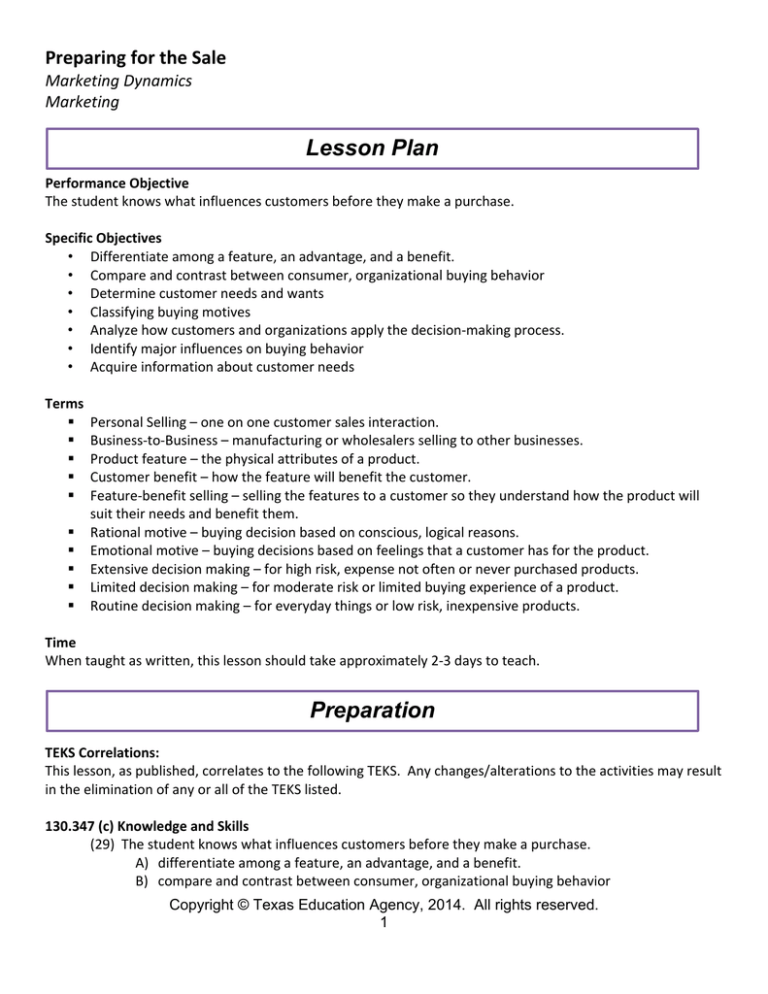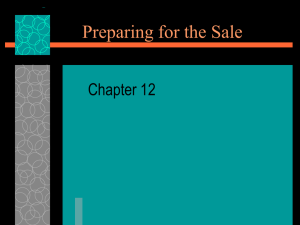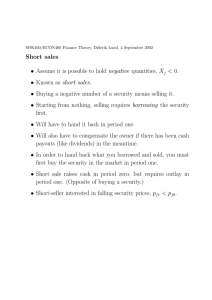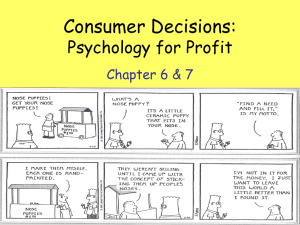Lesson Plan Preparing for the Sale Marketing Dynamics Marketing
advertisement

Preparing for the Sale Marketing Dynamics Marketing Lesson Plan Performance Objective The student knows what influences customers before they make a purchase. Specific Objectives • Differentiate among a feature, an advantage, and a benefit. • Compare and contrast between consumer, organizational buying behavior • Determine customer needs and wants • Classifying buying motives • Analyze how customers and organizations apply the decision-making process. • Identify major influences on buying behavior • Acquire information about customer needs Terms Personal Selling – one on one customer sales interaction. Business-to-Business – manufacturing or wholesalers selling to other businesses. Product feature – the physical attributes of a product. Customer benefit – how the feature will benefit the customer. Feature-benefit selling – selling the features to a customer so they understand how the product will suit their needs and benefit them. Rational motive – buying decision based on conscious, logical reasons. Emotional motive – buying decisions based on feelings that a customer has for the product. Extensive decision making – for high risk, expense not often or never purchased products. Limited decision making – for moderate risk or limited buying experience of a product. Routine decision making – for everyday things or low risk, inexpensive products. Time When taught as written, this lesson should take approximately 2-3 days to teach. Preparation TEKS Correlations: This lesson, as published, correlates to the following TEKS. Any changes/alterations to the activities may result in the elimination of any or all of the TEKS listed. 130.347 (c) Knowledge and Skills (29) The student knows what influences customers before they make a purchase. A) differentiate among a feature, an advantage, and a benefit. B) compare and contrast between consumer, organizational buying behavior Copyright © Texas Education Agency, 2014. All rights reserved. 1 C) D) E) F) G) determine customer needs and wants classifying buying motives analyze how customers and organizations apply the decision-making process. identify major influences on buying behavior acquire information about customer needs Interdisciplinary Correlations: English-English III • 110.33(b)(1) Reading/Vocabulary Development. Students understand new vocabulary and use it when reading and writing • 110.33(b)(12) Reading/Medial Library. Students use comprehension skills to analyze how words, images, graphics and sounds work together in various forms to impact meaning. Students will continue to apply earlier standards with greater depth in increasingly more complex texts. • 110.33(b)(21) Research/Gathering Sources. Students determine, locate, and explore the full range of relevant sources addressing a research question and systematically Math-Algebra I • 111.32(b)(1)(E). Interpret and make decisions, predictions, and critical judgments from functional relationships. Social Studies-World Geography Studies • 113.43(c)(23)(A) plan, organize, and complete a research project that involves asking geographic questions; acquiring, organizing, and analyzing information; answering questions; and communicating results; Occupational Correlation (O*Net - http://www.onetonline.org/) Job Title: Retail Salespersons O*Net Number: 41-2031.00 Similar Job Titles: Sales Associate, Sales Consultant, Sales Clerk, Sales Person, Customer Assistant, Clerk, Sales Representative, Design Consultant, Salesman, Bridal Consultant Tasks: • • • • • • • • • • Greet customers and ascertain what each customer wants or needs. Describe merchandise and explain use, operation, and care of merchandise to customers. Recommend, select, and help locate or obtain merchandise based on customer needs and desires. Compute sales prices, total purchases and receive and process cash or credit payment. Answer questions regarding the store and its merchandise. Prepare sales slips or sales contracts. Maintain knowledge of current sales and promotions, policies regarding payment and exchanges, and security practices. Maintain records related to sales. Demonstrate use or operation of merchandise. Place special orders or call other stores to find desired items. Soft Skills: Active Listening, Reading Comprehension, Critical Thinking, Speaking, Coordinating, Active Learning. Copyright © Texas Education Agency, 2014. All rights reserved. 2 Accommodations for Learning Differences It is important that lessons accommodate the needs of every learner. These lessons may be modified to accommodate your students with learning differences by referring to the files found on the Special Populations page of this website. Preparation • Review and familiarize yourself with the terminology, website links, and digital presentations. • Teacher will have assignments and website information ready to distribute to students. Instructional Aids • • • • Textbook Display for digital presentation, websites for assignments and class discussion Instructor Computer/Projection Unit Online Websites Introduction The main purposes of this lesson are to help students understand • How to differentiate between a product feature and a benefit • How to determine customers needs • The decision making process that customers use when purchasing products. ASK: Ask students to share their worst experience when purchasing products. SAY: Explain that many of these situations can be alleviated if the sales person had done their homework in the first place. It is the role of the sales person to figure out what the customers want and show them products that meet those specifications. ASK: What traits do you think you need to be a good salesperson? SAY: Explain that sales people need to be able to communicate well, have good attitude and know their products well. If a sales person cannot communicate or talk in circles their customers will have hard time understanding them and they probably will not make many sales. ASK: What how important do you think a good sales person is to a company? SAY: Explain that sales people are always in demand. Companies understand that if they do not have someone to sell their products they will not make money. Good sales people can make hundreds of thousands of dollars or more. These are usually sales people who sell in the business-to-business market. Copyright © Texas Education Agency, 2014. All rights reserved. 3 Outline MI Outline Instructor Notes I. Types of Sales A. Personal Selling B. Business-to-business C. Feature Benefit Selling 1. Product Features 2. Customer Benefits II. Customer Buying Motives A. Rational motive 1. Dependable product 2. Cost savings 3. Better health 4. Safety considerations 5. Quality of product B. Emotional motives 1. Social approval 2. Recognition 3. Power 4. Love 5. Prestige III. Customer Decision Making A. Extensive Decision Making B. Routine Decision Making C. Limited Decision Making IV. Good Sales Characteristics? A. Communication & Interpersonal skills B. Technical skills C. Positive attitude and self-confidence D. Goal-oriented E. Empathy, Honesty, Enthusiasm V. Sales techniques A. Determining Needs B. Observing C. Listening D. Questioning Teacher will lead the discussion of material, using multimedia presentations of preparing for the sale. Assign students the guided practice of determining benefits from the products features. It is suggested that the students present their projects to the class. Students will complete independent activities, whether individually, or in pairs or groups at the discretion of the teacher. Explain to students the importance of the steps of the sale to the sales manager. Following these steps helps to increase sales and therefore company revenue. Go over the criteria in the assignment and check for understanding. Multiple Intelligence Guide Existentialist Interpersonal Intrapersonal Kinesthetic/ Bodily Logical/ Mathematical Musical/Rhythmic Naturalist Verbal/Linguistic Copyright © Texas Education Agency, 2014. All rights reserved. 4 Visual/Spatial Application Guided Practice Feature and Benefits Practice Students will choose a product in which they are interested. The product needs to be a fairly technical product, like a computer, cell phone, car accessory or camera. They will fold a piece of paper lengthwise so they have two sides of the paper. They will research the features of the product and provide a list of the features on one side of the paper. On the other side of the paper they will list the benefit of that feature in easy to understand terms beside the feature. Once they have their lists complete they will present the list to the class. Independent Practice Product Decision Making Process Students will break into groups of three or four. Each group will create a digital presentation that will show each of the categories of decision making. They will list the criteria for that category of decision making and they will choose at least five products that fit into that category. They will need to explain why those products fit into that decision making process. They will present their presentations to the class. Summary Review It is important for sales people to know their products and be able to determine their customer’s wants and needs. By understanding how product features translate into customer benefits they can help their customers to find the products that they need and make a sales for their company. There are different levels of customer’s decision making also. Different products fall into these categories and depend upon the customer’s level of experience with products. Sales people can help shorten the decision making process by understanding these processes and their customers and help guide them to the products that best suit their needs. Evaluation Informal Assessment Instructor should observe the work ethic of individuals involved in class discussions and the independent practice activity Formal Assessment Students will be evaluated on their Feature/Benefit Practice and their Product Decision Making Presentation. Students will also be assessed on their use of the word processing skills and the neatness, formatting, grammar and spelling of their resumes. Copyright © Texas Education Agency, 2014. All rights reserved. 5 Enrichment Extension Product Feature/Benefit Chart Students will choose five products that they wish to research. They will create a digital presentation that explains the feature and benefits of each product and what type of customer decision making process would most likely be used for that product. These products should be a mix of retail products and business to business products. Copyright © Texas Education Agency, 2014. All rights reserved. 6 Preparing for the Sale Marketing Dynamics Marketing Independent Practice Customer Decision Making Presentation Create a digital presentation describing the categories of decision making discussed in the classroom. The presentation should contain the following elements: 1. Categories of decision making 2. Criteria for decision making 3. List Five Products for each category of decision making 4. Explain why you picked the products as examples of decision making The presentation MUST meet the following requirements: • 8-10 Slides • Use multiple transitions and layouts • Creative use of images throughout the presentation Copyright © Texas Education Agency, 2014. All rights reserved. 7 Preparing for the Sale Marketing Dynamics Marketing Independent Practice Decision Making Presentation Rubric Elements Excellent Up to 20 points Needs Improvement Up to 10 Points Multiple transitions Some transitions A single transitions between slides and between slides and between slides and build effects build effects no build effects Picture on each slide 6-8 pictures in 4-6 pictures in relevant to the presentation presentation content relevant to content relevant to content All categories three All three categories All three categories categories of are listed and some are listed but little customer decision explanation is given or no explanation is making is listed and provided explained in detail Five products are Five products are Three or more provided for each provided but products are listed. category with an explanation is explanation of each limited Student is dressed Student is dressed Student is dressed as a business as business in casual clothing professional. professional. and speaks with Student speaks with Student speaks some knowledge of confidence and with knowledge of information. knowledge of information. information. Use of fonts and creative layouts Pictures Decision Making Categories Products Covered Presentation of information Good Up to 15 Points Total: _____________ Copyright © Texas Education Agency, 2014. All rights reserved. 8 Score





